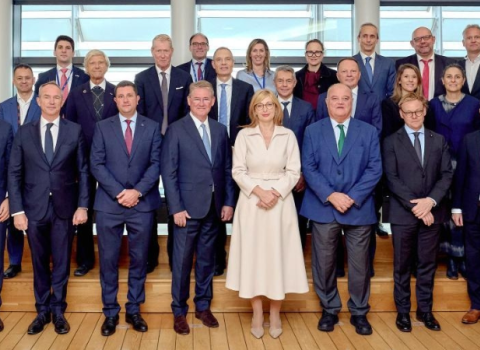The US Solicitor General says the US Patent and Trademark Office is wrong to have granted patents on isolated DNA, as the US Court of Appeals for the Federal Circuit hears oral arguments in the Myriad gene patenting case
IP|Business is supported by Foley & Lardner LLP
On April 4, 2011, the US Court of Appeals for the Federal Circuit heard oral arguments in Association for Molecular Pathology et al. v. US Patent & Trademark Office et al., also known as the Myriad gene patenting case. Here, Myriad Genetics appeals a March 29, 2010 decision by Judge Sweet of the US District Court for the Southern District of New York, which invalidates challenged claims in seven Myriad patents as patent-ineligible under 35 U.S.C. § 101.
Background
Myriad owns or is the exclusive licensee of a series of patents claiming isolated DNA compositions, as well as methods for testing for the presence of genetic mutations that correlate with an increased risk of certain breast and ovarian cancers. Exemplary claims at issue relate to: (1) compositions of matter consisting of isolated DNA encoding all or part of the BRCA1 or BRCA2 genes, and (2) methods of using the isolated DNA to detect mutations in BRCA1 and BRCA2 by analyzing a gene sequence in a patient sample, or by comparing such a sequence to a normally occurring gene.
A coalition of plaintiffs, led by the American Civil Liberties Union (ACLU), challenged such claims as encompassing patent-ineligible subject matter, that is, products of nature. The district court determined that all claims at issue were invalid because they encompassed non-statutory subject matter under 35 U.S.C. § 101.
On appeal, Myriad challenged the district court's (1) grant of summary judgment in ACLU's favor regarding subject matter ineligibility under § 101; and (2) denial of Myriad's motion to dismiss the case for lack of standing and subject matter jurisdiction.
More than 15 amicus (“friend of the court”) parties, including BIO, AIPLA, IPO, Rosetta Genomics, George Mason University, and Alnylam Pharmaceuticals, filed amicus briefs arguing that the district court erred, at least in determining that the isolated DNA composition claims did not qualify as patent-eligible subject matter.
At least 12 other amicus parties, including the American Medical Association, American Society of Human Genetics, American College of Obstetricians and Gynecologists, American College of Embryology, and the Medical Society of the State of New York, filed amicus briefs supporting affirmance of the district court decision.
Surprisingly, contrary to previous positions of the US Patent and Trademark Office (USPTO), the US Department of Justice (DOJ) filed an amicus brief arguing that claims directed to isolated genomic DNA should not qualify as patent-eligible subject matter under § 101. (The DOJ brief did not address Myriad's method claims.)
As stated by the DOJ, § 101, “Requires something more than identifying and isolating what has always existed in nature.” The DOJ drew a line between naturally-occurring DNA sequences and DNA sequences that do not exist in nature, stating, “Nearly any man-made transformation or manipulation of raw materials of the genome” is patent-eligible, including cDNAs and other engineered DNA molecules, vectors and recombinant plasmids, chimeric proteins, and “countless industrial products,” such as vaccines and genetically modified crops.
Notably, after the case was fully briefed and awaiting oral argument scheduling, acting US Solicitor General Katyal informed the Federal Circuit that he would “personally” argue the government's position at oral argument. It is unprecedented for a US Solicitor General to argue a case at the Federal Circuit, especially where the government is not a plaintiff or defendant.
The Oral Hearing
During oral argument at the Federal Circuit, a three-judge panel (Judges Lourie, Bryson, and Moore) appeared interested in both standing/jurisdiction and substantive patent-eligibility considerations. Thus, the parties divided their time between both issues. The court also gave the DOJ time to present the government's views on patent-eligibility.
Standing/Jurisdiction
Myriad argued that no standing or declaratory judgment jurisdiction exists because there is no real or immediate controversy between the parties. Myriad’s counsel pointed out that the only affirmative actions by Myriad constituted letters sent in 1998, long before the ACLU brought this suit. Judge Moore noted, however, that the recipients could have been operating under the continuing influence of those “cease and desist” letters. On the other hand, Judge Moore herself pointed out that Judge Sweet's rationale in support of standing was so broad that any customer wanting access to any cheaper product would have standing to challenge a patent.
The ACLU argued that the US Supreme Court's decision in MedImmune v. Genentech, 549 U.S. 118 (2007), eliminated any requirement for “immediacy” as a prerequisite to declaratory judgment jurisdiction. Judge Moore probed this issue further, referring to the Supreme Court's decision in Lujan v. Defenders of Wildlife, 504 U.S.555 (1992), where the Court held that “‘some day’ intentions” without “concrete plans” are not sufficient to confer jurisdiction. Judge Moore and Judge Bryson seemed to agree that affidavits of certain plaintiffs who had received the strongest cease and desist letters from Myriad were the weakest on alleging injury, because they attested only that they would consider performing BRCA testing if the Myriad patents were invalidated, not that they actually would do so.
Patent-Eligibility Under 35 U.S.C. § 101
On the merits, Judge Bryson asked both parties if the act of sequencing a person's entire genome would infringe the isolated DNA claims. Myriad said no, because of the “isolated” requirement. The ACLU said yes, because the BRCA genes are present in the human genome. The judges also asked the parties how they would decide the patent-eligibility of a mineral isolated from a rock or of elemental lithium, which does not exist in nature in elemental form.
Judge Lourie seemed willing to adopt a test centering on whether covalent bonds are broken. Interestingly, he suggested drawing a line between “purification,” which he might not view as conferring patent-eligibility, and “isolation,” which he might view as sufficient if the isolation process involves breaking covalent bonds. The ACLU argued that isolated DNA is identical to DNA, and argued that all Myriad did was “snip the gene.” Judge Lourie did not appear persuaded by that argument, pointing out that isolating DNA was “not research by tweezers.”
With regard to the method claims, Judge Lourie asked Myriad whether the methods were merely directed to thought processes. In response, Myriad stated that, like the claims at issue in Prometheus Laboratories, Inc. v. Mayo Collaborative Services, 581 F.3d 1336 (Fed. Cir. 2009), the method claims at issue involved transformative steps. The ACLU disagreed, arguing that the claims encompass mere comparisons of sequence data per se, that is, mental thinking.
The DOJ's Arguments
Solicitor General Neal Katyal argued separately to present the government's position regarding the isolated DNA claims. He urged the Court to adopt a “magic microscope” test for patent-eligibility. That is, if a “magic microscope” could “see” the claimed nucleotide sequence in nature, it should not be patent-eligible under 35 U.S.C. § 101. He explained that the magic microscope could see both full-length DNA sequences and partial DNA sequences, but not sequences that do not occur naturally, such as cDNA sequences.
Solicitor General Katyal then stated that the government has looked into the issue, and believes that the majority of DNA patents would survive this test, because most have claims that recite cDNA or other non-naturally occurring DNA sequences, or have method claims.
Judge Moore pointed out the apparent disagreement between the DOJ and the USPTO, given that the USPTO has been granting patents on isolated DNA for 35 years, and has not withdrawn the Utility Guidelines that support the patent-eligibility of such claims. Solicitor General Katyal responded that the USPTO is “wrong.”
Judge Moore also raised the issue of stare decisis, and asked Solicitor General Katyal whether the issue is one that Congress should decide. In response, he argued that patent-eligibility is a fundamentally legal question, and that 35 years of USPTO practice cannot blur the line that 35 U.S.C. § 101 draws against products of nature.
The Court's Opinion
An opinion by the Federal Circuit is not expected for at least a few months. In fact, considering its potential complexity, importance and controversial aspects, a decision on the merits could take much longer. While predicting results from oral argument is nearly always akin to “reading tea leaves,” the Court may very well find standing and jurisdiction, albeit likely on narrow grounds. Resolving the case on the merits will likely be more difficult, but at least Judge Lourie appeared willing to formulate a test that would uphold the patent-eligibility of Myriad's isolated DNA claims.
While an upcoming Federal Circuit opinion could provide guidance and have significant impact, further resolution of the patent-eligibility issue may eventually come from the U.S. Supreme Court. Any ultimate decision will likely have far-reaching implications on existing intellectual property rights, as well as current and future patent strategies, particularly in biotechnology-related fields.
Jacqueline Wright and Courtenay Brinckerhoff are partners with Foley & Lardner LLP





 A unique international forum for public research organisations and companies to connect their external engagement with strategic interests around their R&D system.
A unique international forum for public research organisations and companies to connect their external engagement with strategic interests around their R&D system.